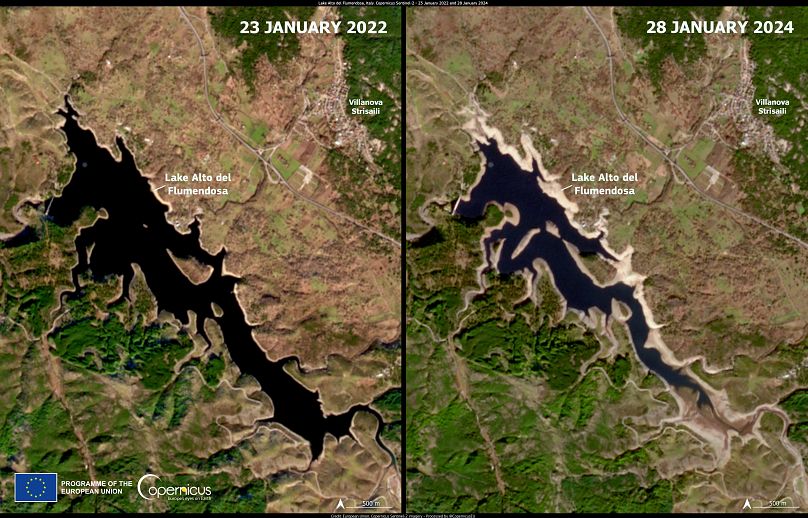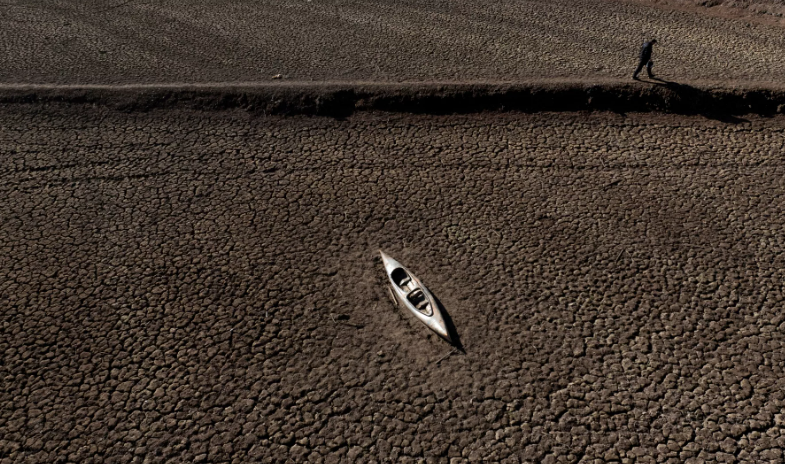High temperatures and low rainfall have left parts of the Mediterranean in a critical condition.
Earlier this month, Catalonia declared a drought emergency. With levels in reservoirs as low as 16 per cent of capacity and no rain in some areas for three years, authorities brought in restrictions on how much water residents can use.
But Spain isn’t the only country suffering as southern Europe’s water supplies run low.
Around 17 per cent of EU territory is now facing serious drought conditions, according to the European Drought Observatory’s latest update.
Just over 1 per cent is at the highest level of warning.
“If we look at the current conditions, based on the latest data we have available up until the end of January, we see that many areas in the Mediterranean region are actually already in either warning or alert drought conditions,” says Andrea Toreti, coordinator of the Copernicus European and Global Drought Observatories.
“We have seen in the last three years a set of recurrent drought events that have affected these areas.”
A combination of drought and heatwaves have triggered the biggest impact in the region over the last few years.
Where else is drought having the biggest impact?
Last week, Sicily – included in that 1 per cent – announced a ‘state of natural disaster’ with water levels in reservoirs running low. Officials said that January was the fifth consecutive month to record rainfall lower than average for the period.
In total, the island has faced nearly eight months of “almost total aridity”, according to the ANBI Observatory on Water Resources with the second half of 2023 the driest in 100 years.
Though rain fell over large parts of Italy last week, replenishing supplies for many, it wasn’t enough to fix the deficit in Sicily. And, the ANBI points out, heavy rain on already dry land accelerates erosion increasing the risk of desertification.
Further north on another Italian island, Sardinia is also in trouble with some reservoirs at less than 50 per cent of capacity. Satellite images from EU’s Copernicus Climate Change Service in January clearly showed a significant decrease in the water level of Lake Alto del Flumendosa, which supplies fresh water to a large part of eastern Sardinia.

In several sub-regions in the centre of the island, local authorities banned the use of water for irrigation on 12 January. Farmers have also been raising the alarm about the water emergency brewing across the rest of Sardinia.
North Africa too is suffering from this recurrent drought. Morocco is seeing its sixth consecutive year struggling with water supplies. Rainfall is 70 per cent lower than in an average year, according to the country’s water and agriculture ministers.
Is there hope for more rain in Europe?
In the regions currently experiencing drought, seasonal forecasts are pointing to warmer than usual temperatures in the coming months. Even if there are normal levels of rainfall, abnormal temperatures could still mean the situation across the Mediterranean becomes even more critical.
“There was not, in some of these areas, a full recovery from these extremes. And now, of course, we see again the lack of precipitation but also the warmer than usual temperatures,” Toreti explains.
Another factor to consider is snow melt. Without temperatures low enough for snow to fall and stick around, the usual spring melt won’t replenish water supplies.
Toreti says that the data we have now shows that conditions are even worse than they were in 2022 – a record year in terms of area affected and low snow meltwater.
Aside from water available for people to drink or to irrigate crops, this also poses problems for generating energy from hydropower which is dependent on the availability of water.
Is climate change making Europe’s droughts worse?
Toreti says what is happening is “part of the evolving climate change due to human greenhouse gas emissions.
“Because basically what is happening is that Europe is facing a change in precipitation regimes.”
Winter is when these regions usually have a chance to recover or balance a lack of water in warmer seasons and prepare for summer.
“Nowadays this sort of equilibrium has been modified.”
If we don’t take better global action right now, Europe is going to face much higher risk connected with drought.
Though it can’t directly be attributed to climate change without more detailed studies, he says it is in line with what projections are showing for future climate conditions in the Mediterranean.
“If we don’t take better global action right now, Europe is going to face much higher risk connected with drought. We’ll deal with heat waves but also with heavy precipitation.
“All of these extremes are projected to occur more frequently but also be more intense. And the recurrent drought is something that might become the new normal already by mid-century if we don’t act right now.”




